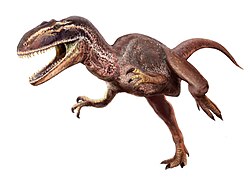Arthropods
Newly named insects
| Name | Novelty | Status | Authors | Age | Unit | Location | Notes | Images |
|---|---|---|---|---|---|---|---|---|
Comb nov | Syn | Late Eocene | A Dolichoderin ant |  | ||||
| List of years in paleontology |
|---|
| (table) |
Paleontology or palaeontology is the study of prehistoric life forms on Earth through the examination of plant and animal fossils . [1] This includes the study of body fossils, tracks ( ichnites ), burrows , cast-off parts, fossilised feces ( coprolites ), palynomorphs and chemical residues . Because humans have encountered fossils for millennia, paleontology has a long history both before and after becoming formalized as a science . This article records significant discoveries and events related to paleontology that occurred or were published in the year 1964.
| Name | Novelty | Status | Authors | Age | Unit | Location | Notes | Images |
|---|---|---|---|---|---|---|---|---|
Comb nov | Syn | Late Eocene | A Dolichoderin ant |  | ||||
| Name | Novelty | Status | Authors | Age | Location | Notes | Images |
|---|---|---|---|---|---|---|---|
Gen et sp nov | Valid | Soot-Reyn | New genus and species with five other species moved from other genera | ||||
| Taxon | Novelty | Status | Author(s) | Age | Unit | Location | Notes | Images |
|---|---|---|---|---|---|---|---|---|
| Chilantaisaurus tashuikouensis [4] | Gen. et sp. nov. | Valid | Hu | Turonian | Ulansuhai Formation | A member of Neovenatoridae |  | |
| Eustreptospondylus oxoniensis [5] | Gen. et sp. nov. | Valid | Walker | Callovian | Oxford Clay Formation | A megalosaurid |  | |
| Eustreptospondylus divesensis [5] | Sp. nov. | Valid | Walker | Callovian | Marnes de Dives | Later given the genus Piveteausaurus | ||
| Fabrosaurus australis [6] | Gen. et sp. nov. | Nomen dubium . | Ginsburg | Sinemurian | Upper Elliot Formation | An early ornithischian | ||
| Lambeosaurus paucidens [7] | Comb. nov. | Nomen dubium | Ostrom | Campanian | Judith River Formation | A new combination for Hadrosaurus paucidens , which may be a ceratopsian | ||
| Metriacanthosaurus [5] | Gen. nov. | Valid | Walker | Oxfordian | Oxford Clay Formation | A new species for Megalosaurus parkeri |  | |
| Name | Novelty | Status | Authors | Age | Unit | Location | Notes | Images |
|---|---|---|---|---|---|---|---|---|
Sp. nov. | Valid | A Meleagridae. | ||||||
Sp. nov. | Valid | An Anatidae. | ||||||
Sp. nov. | Valid | Howard | Late Pleistocene |
| A Strigidae. | |||
Sp. nov. | jr synonym | Brodkorb | An Anatidae, transferred to Anas greeni . | |||||
Gen et Sp. nov. | jr synonym? |
| A Pseudodontornithidae, type species T. wetmorei, | |||||
| |||||||||||||||||||||||||
| ||||||||||||||
| Name | Novelty | Status | Authors | Age | Unit | Location | Notes | Images |
|---|---|---|---|---|---|---|---|---|
Gen et Sp. nov. | Valid | Cooper | Late Cretaceous (Campanian) | A tardigrade; originally placed in its own family (Beornidae), it was later reclassified as a member of the Hypsibiidae. [14] |  | |||